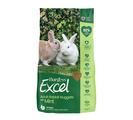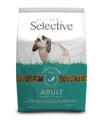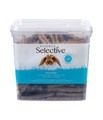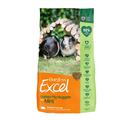You might not know it, but dental disease is fairly common in rabbits, guinea pigs and chinchillas because of their ‘hyposodont’ dentition. This means that their teeth never stop growing, unlike dogs, cats and humans whose brachyodont teeth have true roots that grow for a limited time only. Rabbits, guinea pigs and chinchillas are adapted for continual foraging so their teeth are routinely worn down and therefore need to keep growing.
However, this poses problems if foraging doesn’t happen on a regular basis as the teeth aren’t worn down but still continue to grow. In fact, rabbit teeth grow at an alarming rate of up to 5mm per week! If the teeth get too long they can greatly impede eating and your small animal may starve. In extreme cases, the incisors are so overgrown that they break upwards into the nasal passage and eye socket, causing severe pain and subsequent infection.
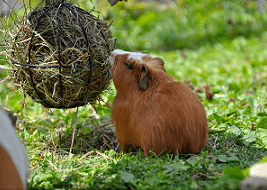 The best way to avoid this happening is to feed a high fibre, low nutrient diet including grass and hay. This is especially important if your small animal is housed exclusively indoors and has limited access to natural forage. Prevention is much easier than cure, so stop dental disease in its tracks by feeding the correct diet from the beginning. Other than that, just be vigilant and conduct regular checks on the state of your pet’s teeth and mouth.
The best way to avoid this happening is to feed a high fibre, low nutrient diet including grass and hay. This is especially important if your small animal is housed exclusively indoors and has limited access to natural forage. Prevention is much easier than cure, so stop dental disease in its tracks by feeding the correct diet from the beginning. Other than that, just be vigilant and conduct regular checks on the state of your pet’s teeth and mouth.
Dental disease can arise for a number of reasons besides improper diet, including genetic or congenital defects and traumatic injury. If you are able to, it is worth conducting regular oral examinations of your animals to keep tabs on their teeth and gums. Sometimes visible problems will be immediately evident, such as growth abnormalities and sores along the gum line, and other times the problems will be out of sight and require a radiographic examination to detect. Problems with the molars and cheek teeth are a lot harder to notice without veterinary intervention.
If you suspect dental disease in your rabbit, guinea pig or chinchilla, look out for the following signs: ocular and nasal discharge, drooling, teeth grinding, bad breath, selective or lack of eating, and weight loss. Before contacting your vet, have a quick look for yourself. [Note: only do this if you feel comfortable and confident with handling your pet. Some animals won’t like being examined and will fidget and try to get away. If this happens, stop immediately, as you don’t want to injure your pet or yourself.]
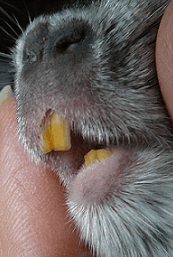 If, however, your pet allows you to examine it, follow these simple steps:
If, however, your pet allows you to examine it, follow these simple steps:
- Position your rabbit/guinea pig/chinchilla between your knees on the floor and have a feel along the side of its face and jaw. There should be no obvious swellings or bulges and your pet shouldn’t flinch when firmer pressure is applied. If it does, it’s possible you’re touching a tender point along the gum.
- If you can, gently part your pet’s lips and have a quick look at the four incisors at the front of the mouth (two up, two down). The gums should look pink and healthy and the teeth should be firm not loose. They shouldn’t overlap or curve excessively and the gums around them shouldn't look red, swollen or sore. Sometimes when the incisors elongate, they twist, so keep your eyes peeled for this too.
- Should you notice any problems or abnormalities during the examination, take your animal straight along to the vet.
If you have any advice on preventing dental disease or detecting it in its early stages, please share it with our other readers! Feel free to email me directly ([email protected]) or comment below with any questions.
Written by: Hannah

